Meryon 1960–1 (Tate T00926) brings the central problem in the interpretation of Franz Kline’s work into focus: in several senses, Kline’s ‘breakthrough’ – a term that will be problematised below – occurred belatedly. It was also paradoxical, in the sense that the discovery of his distinctive variety of gestural abstraction, in combination with his particular palette of black and white, post-dated the breakthroughs of Jackson Pollock and Willem de Kooning, as well as those of Mark Rothko and Barnett Newman. Kline’s artistic discovery, and its public debut in his one-man show at the Charles Egan Gallery, New York, in late 1950, thus took place after the breakthroughs of others and came in their wake and model. Additionally, Kline’s combined breakthrough style and palette only became identifiable as uniquely important and uniquely his own after he reaffirmed it a decade later in his reversion to black and white in works like Meryon, and after his death in 1962 precluded the possibility of another, equivalent breakthrough. As the analysis of contemporary criticism given elsewhere in this In Focus demonstrates, critics who saw the exhibition in which Meryon was first shown – held in late 1961 at the Sidney Janis Gallery, New York – were expecting at that point a ‘change’ in artistic orientation and considered Kline’s return to his black and white palette to be the product of a failure to develop his artwork.1
It is crucial to note that the now-standard account of Kline’s breakthrough appeared in its final and current form in 1962. It thus emerged long after the artistic ‘breakthrough’ itself took place, which may have been in 1948, 1949 or 1950, and appeared very soon after Kline’s death. Thus, while Kline’s ‘breakthrough’ refers to an event from the late 1940s, the specific description that we have inherited was created and achieved currency in the early 1960s. Since this period, Kline’s artistic accomplishment has been defined through this dramatic narrative account of his breakthrough, which is why it is so important to any study of Kline’s work. It is in this context and with these stakes in mind that Meryon can be situated as Kline’s revisiting of his breakthrough, which occurred alongside other contemporary attempts to come to terms with the significance of Kline’s achievement and with the particular trajectory of his development.
Problematising the term
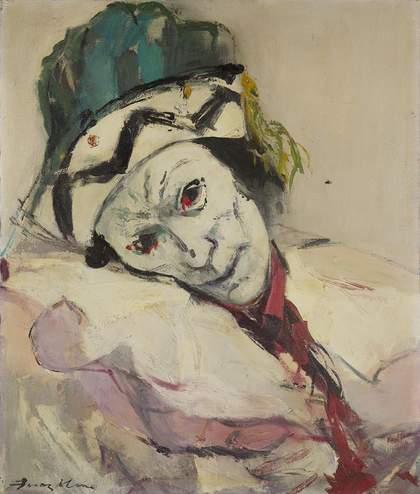
Fig.1
Franz Kline
Large Clown (Nijinsky as Petrouchka) c.1948
Oil on canvas
841 x 714 mm
Wadsworth Atheneum Museum of Art
© ARS, NY and DACS, London 2017
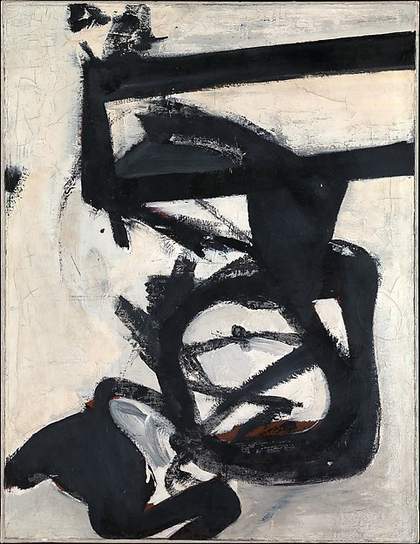
Fig.2
Franz Kline
Nijinsky 1950
Enamel on canvas
1156 x 886 mm
Metropolitan Museum of Art, New York
© ARS, NY and DACS, London 2017
How to explain the enormous stylistic difference between the two paintings of the ballet dancer Vaslav Nijinsky in the role of the puppet Petrushka that Franz Kline created in c.1948 and 1950 (figs.1 and 2)? ‘In 1949, he broke through’, wrote art critic Thomas Hess in 1962 in his obituary of Kline published in Art News, which was then the most widely circulated art magazine in the world. Hess continued,
It was a solution, not vertigo, and a resolution – certainly influenced by the examples and personalities of his friends Willem de Kooning and Jackson Pollock, just as surely as his spirit and personality would strongly mark their separate achievements. Starting with motifs from swift brush drawings, wrenched out of scale by enlargement, he forged a style and an image out of the broken past with the verve and speed that Siegfried forged his sword. He made white masses and speeds and black masses and speeds meet with blunt force inside the exactly reckoned quadrangle of the canvas. Here railroad engines and cars, city- and landscapes, faces and gestures, are all lost in his shapes; he throws away the tasteful cookery of oil pigment, the direct backing of the Old Masters and all precedence of rules. And his original meaning, his content (raison d’être) are redeemed.2
Much was at stake in Hess’s use of the words ‘broke through’, which had already become a trope of abstract expressionist discourse by 1962. Of these stakes Hess was acutely aware as a critic and the editor of Art News. Hess had championed the American abstract expressionists as the heirs to European abstraction, which, as Hess argued in his 1951 book on the movement titled Abstract Painting: Background and American Phase, had formerly been centred in Paris and had recently relocated to New York: ‘New York becomes Paris for the art of its time, and also takes over Paris’ tradition.’3 Over the course of the 1950s, more than ‘take over’, the phrasal verb ‘break through’ caught on in American art criticism in order to explain how the New York School displaced and replaced the School of Paris. ‘Take over’ involved appropriation from another group and smacked of theft, as was suggested in the title, decades later, of art historian Serge Guilbaut’s landmark study of abstract expressionism, How New York Stole the Idea of Modern Art.4 While also violent, the phrase ‘break through’, by contrast, emphasised intellectual discovery and described a hard-fought and well-deserved triumph over a formidable obstacle, rather than against an opponent or competitor. Nowhere was this phrasing debated and decided upon explicitly, but it solidified into a compound noun and ‘breakthrough’ became the premise for the greatness of the New York School.
Fundamentally, the trope was a rhetorical dramatisation of one of modernism’s main imperatives: the rejection of tradition. In the specific context of abstract expressionism, a breakthrough entailed a move away from figuration towards abstraction and, most particularly, from the European tradition of painting towards a unique personal style. Given the frequency of breakthroughs among artists in the US during the late 1940s, they appeared to amount to more than disparate discoveries and increasingly gave the impression of a collective American artistic movement. In 1959 the critic Irving Sandler could generalise that ‘The experience of breakthrough was a common one in the late Forties among a group of New York painters, who despite their objections to any labels, are called Abstract Expressionists or Action Painters.’5
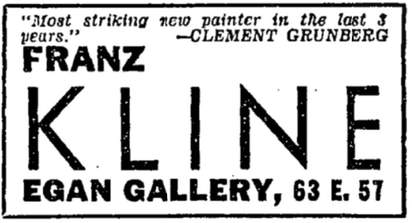
Fig.3
Advertisement for Franz Kline’s exhibition at the Charles Egan Gallery, New York, New York Times, 29 October 1950, p.X9
In general, a breakthrough is both purely intellectual, or artistic, and necessarily social, requiring that it be recognised as such by a significant number of others. Hess and similarly engaged art critics emphasised the former aspect while implicitly providing, in their passionate and consistent advocacy of the abstract expressionists, the public acknowledgement in print that served to certify these breakthroughs. It is thus possible to discriminate between artistic and professional breakthroughs, which usually and ideally – that is, if the public is sympathetic to the art – follow on from one another so quickly that they are virtually identical. In Kline’s case, when his first abstract works debuted his show at the Charles Egan Gallery in 1950, they were already certified as constituting a breakthrough comparable to the recent breakthroughs of the leading American artists. The advertisement that ran for the exhibition in the New York Times quoted a statement by no less an authority on contemporary art than the influential critic Clement Greenberg, describing Kline as the ‘Most striking new painter in the last 3 years’ (fig.3).6 In Kline’s case, not only did these artistic and professional breakthroughs appear to occur at once but they also coincided with a series of group exhibitions staged in New York around this time. These included Talent and Black or White at the Samuel Kootz Gallery and Young Painters in the U.S. and France at the Sidney Janis Gallery, all held in 1950, and the important Ninth Street show, which was organised by the dealer Leo Castelli and displayed in a rented space in Greenwich Village in 1951.
After their breakthroughs, Pollock and de Kooning chose to deliberately disturb the expectations of their viewers and critics when they debuted their black pourings and Women series, respectively, during the early 1950s. Pollock wrote in 1951, ‘I’ve had a period of drawing on canvas in black – with some of my early images coming thru – think the non-objectivists will find them disturbing – and the kids who think it simple to splash a Pollock out.’7 When Pollock and de Kooning returned to figuration and more colour in these works, it was considered a reactionary retreat from the historic adventure of abstraction. In 1953, for example, Time magazine reported that, ‘Some pained partisans of abstract art pointed out that de Kooning was attempting to ride two horses (representation and abstraction) at once, and thought he failed.’8
Unlike Pollock and de Kooning, whose departures from their breakthroughs registered as turnarounds and even defections, Kline more cautiously developed his breakthrough style, only really veering off course during the later 1950s with his paintings in colour (see, for instance, Orange and Black Wall 1959, Museum of Fine Arts Houston, Houston; Dahlia 1959, Whitney Museum of American Art, New York; and Torches Mauve 1960, Philadelphia Museum of Art, Philadelphia). Even this deviation, however, was not provocative in the manner of Pollock and de Kooning’s reversals. Kline’s paintings in colour were arguably even less figurative than his previous works in black and white, and Kline never completely abandoned his use of that palette.
Kline’s 1950 painting Nijinsky came to epitomise his breakthrough and thus his artistic accomplishment and identity: it was prominently featured in Kline’s first solo exhibition at the Charles Egan Gallery in 1950, as well as in the US pavilion at the Venice Biennale in 1960 (where it was accidentally installed and reproduced in the exhibition catalogue upside down).9 In 1960, the year that Kline began to paint Meryon, Kline’s breakthrough came under threat. The remainder of this essay provides a revisionist account of Kline’s breakthrough, emphasising the related problems that Kline faced in 1950 and 1960: namely, those of artistic independence; expression of identity; technical and conceptual discovery; and membership of the movement of abstract expressionism.
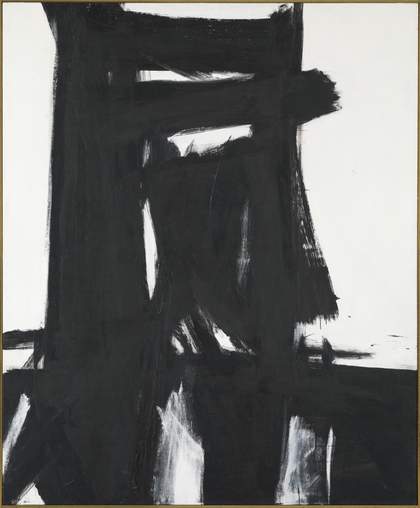
Fig.4
Franz Kline
Meryon 1960–1
Oil on canvas
2359 x 1956 mm
Tate T00926
© ARS, NY and DACS, London 2017
In anticipation of this account it is important to emphasise, even as the history of Kline’s breakthrough is problematised, that he did invent an idiom or signature style that was uniquely his. What is formally unusual about Kline’s characteristic kind of gestural abstraction is not only his insistence upon a black and white palette, which results in the high impact of the highest possible contrast in tones. It is also the shapes of his forms, which are not spontaneous or curvilinear in the manner of previously existing gestural abstraction, including notably that of Pollock and de Kooning. Indeed, Kline’s gestural abstraction tends towards geometric abstraction in the regularity and repetition of his forms and the rigour of his compositions, which look empty relative to the densely packed paintings of Pollock and de Kooning. For instance, the forms in Nijinsky could be seen as a rectangle above a circle above a closed triangle. Similarly, Meryon (fig.4) can be seen as a series of increasingly small, concentric, vertically oriented rectangles, which stand above a horizontally oriented rectangle. What differentiates Kline’s gestural abstraction from historic geometric abstraction is that the logic that links these disparate forms is potentially representational. The elemental shapes in Nijinsky form a body, while the concentric rectangles in Meryon suggest recession in space, although it is unclear whether the smallest rectangular shape, which is completely black, is closest to or furthest from the viewer. The suggestions of figuration in Nijinsky and a reversible three-dimensional space in Meryon are surprising, given the expectations with which a viewer would approach gestural abstraction.
Accounting for Kline’s breakthrough
Kline’s breakthrough occurred after those of Pollock and de Kooning, from which it had to be distinguished – something that Hess understood, as his 1962 obituary reveals. This distinction was especially necessary given the recorded circumstances of Kline’s breakthrough, which had occurred in de Kooning’s studio. By contrast, the breakthroughs of Pollock and de Kooning had been entirely independent, transpiring – true to the romantic model of the solitary artist – while they were alone in their studios. De Kooning’s breakthrough had notably come about with his large-format black and white paintings, such as Painting of 1948 (Museum of Modern Art, New York). That year it was featured in his first one-man show at the Charles Egan Gallery in New York, from which it was purchased directly by the Museum of Modern Art and then exhibited on its walls. Did Kline’s breakthrough belong to him alone, if it was de Kooning who had served as the catalyst? Was Kline’s path sufficiently different from de Kooning’s? In an artistic movement that prized individuality above all, could a breakthrough be born of collaboration or influence? These questions were not articulated during Kline’s lifetime, but they arguably haunted the interpretation of his work, particularly as his legacy was evaluated upon his death.
Six months after Hess penned his effusive obituary, Elaine de Kooning, an art critic, artist and the wife of Willem de Kooning, offered a first-hand account of Kline’s breakthrough in the catalogue for the memorial exhibition held in Kline’s honour at the Washington Gallery of Modern Art, Washington, D.C. According to de Kooning, ‘the key to his self-discovery’ was the ‘hundreds of tiny sketches on small pads, menus, napkins, envelopes, on the backs of bills, on any scrap of paper around a park, cafeteria or studio’.10 Kline had created these in private and in parallel to his more formal and public practice of figurative painting. That de Kooning characterised Kline’s artistic breakthrough as a ‘self-discovery’ is doubly significant: it was attributable to Kline alone, and it constituted the discovery of his personal identity. De Kooning took care, furthermore, not to name her husband, referring to him as ‘a friend’ in her account, which has since become one of abstract expressionism’s classic stories. As such, it deserves to be quoted at length:
One day in 1949, Kline dropped in on a friend who was enlarging some of his own small sketches in a Bell-Opticon. ‘Do you have any of those little drawings in your pocket?’ the friend asked. Franz always did and supplied a handful. Both he and his friend were astonished at the change of scale and dimension when they saw the drawings magnified bodilessly against the wall. A four by five inch brush drawing of the rocking chair Franz had drawn and painted over and over, so loaded with implications and aspirations and regrets, loomed in gigantic black strokes which eradicated any image, the strokes expanding as entities in themselves, unrelated to any reality but that of their own existence. He fed in the drawings one after the other and, again and again, the image was engulfed by the strokes that delineated it.
From that day, Franz Kline’s style of painting changed completely. It was a total and instantaneous conversion, demanding completely different tools and paints and a completely different method of working with a completely different attitude toward his work. Any allegiance to formalized representation was wiped out of his consciousness. The work, from this moment, contradicts in every way all of the work that preceded it, and from which it had so logically and organically grown.11
Since this account’s publication it has transformed into legend, with the cumulative effects of enhancing de Kooning’s reputation and diminishing Kline’s achievement – contrary, perhaps, to its author’s original intentions. It is often repeated without scepticism, despite the fact that critics and scholars have routinely called into question what art historian and critic Dore Ashton has called the ‘Saul-into-Paul conversion theory’ of Kline’s breakthrough.12
What has not been mentioned is that the ‘Saul-into-Paul conversion theory’, published by Elaine de Kooning in Art News in 1958, was not set in Willem de Kooning’s studio and did not mention a ‘Bell-Opticon’, unlike her account of 1962.13 Additionally, while the 1958 account’s introduction dramatised Kline’s breakthrough to abstraction as a ‘transformation of consciousness’, or a ‘revelation’ of Biblical proportions, invoking the example of ‘Saul of Tarsus outside the walls of Damascus when he saw a “great light”’, the description of Kline’s technical and conceptual breakthrough in this account nevertheless resembled previous accounts of Kline’s development in its gradualness, uneventfulness and thoughtfulness.14 The breakthrough that Elaine de Kooning first recounted was a product of sustained technical experimentation and logical thought on Kline’s part, rather than accident or epiphany: ‘Still involved, in 1950, with elements of representation, he began to whip out small brushes of figures, trains, horses, landscapes, buildings, using only black paint. The speed and the weight of the line kept increasing until finally the objective image was overwhelmed by its own outlines.’15 It is worth noting here that her 1958 account Elaine de Kooning dated Kline’s breakthrough to 1950, not 1949 as in her account of 1962, or potentially 1948 as in an interview with Harry Gaugh for the latter’s doctoral dissertation on Kline in 1972.16 This broad range of dates itself suggests that Kline’s breakthrough occurred over time, as a process, rather than in a watershed event.
Three other descriptions of Kline’s breakthrough were similarly undramatic. The first detailed account of Kline’s development was published in the December 1952 issue of Art News in the article ‘Kline Paints a Picture’ by Robert Goodnough. Here Goodnough characterised Kline’s progression towards abstraction as ‘slow’ and ‘gradual’, identifying Kline’s ‘drawings, done between 1942 and 1944’ as ‘a turning point’.17 Such a process did not make for the stuff of legend, although it bore a resemblance to Kline’s own explanation, which he provided to a journalist in 1956:
My work then [in the early 1940s]? Well, it was mostly figure drawing. I kept simplifying the forms in black and white and breaking down the structure into essential elements. Eventually it came to this.’ [Kline] gestured to the giant black-and-white abstractions whose originality and strength have made them a landmark in the world of art.18
Willem de Kooning, when he was interviewed in 1971 by Gaugh, remembered that Kline’s passage to abstraction took place over the course of a year or so: ‘He had a vision of something and sometimes it takes quite a while to work it out. Then, later on, one has to make a break again. It’s very hard to explain. You have to be a painter.’19 What strikes the reader attentive to the trope of the breakthrough in abstract expressionist discourse is that both Kline and de Kooning, in their very brief descriptions, spoke of a break, whether a ‘breaking down’, as Kline did, or simply making ‘a break’, as de Kooning did. Most significant, however, is the rather traditional process of abstraction from a figure that Kline very clearly describes as central to the change in his work at this time. This path towards abstraction differentiates Kline from his peers, who were immersed in automatism, a practice employed by the surrealists in which spontaneous gesture and chance composition rather than conscious thought formed the basis of the creative process.
Kline’s abstraction was never an abstraction ex nihilo but developed out of illustration. In retrospect, a telling detail from Elaine de Kooning’s account of 1962 emphasises how the importance of illustration to Kline’s breakthrough to abstraction has been underestimated. Throughout the literature on Kline, the opaque projector, which has been credited with inspiring his breakthrough, has been erroneously written as Bell-Opticon, following Elaine de Kooning, and not as balopticon. This error usefully indicates the extent to which this optical instrument, which was routinely employed by illustrators, including Norman Rockwell (1894–1978), was foreign to the field of abstract painting. Part of the reason that de Kooning’s account of 1962 has continued to dominate the scholarship on Kline is the compelling nature of this detail, which explains Kline’s breakthrough as the consequence of exposure to an instrument. Kline’s extensive background in illustration, described in another part of this In Focus, nevertheless makes it unlikely that the first time he encountered and experimented with the device was in de Kooning’s studio.20
Within this context, Meryon, created in 1960–1, can be seen as another retrospective account of Kline’s breakthrough to abstraction, this time from the artist’s perspective and articulated in paint and in the title. In this account, however, Kline’s breakthrough style and palette is not framed as a departure from illustration, whether unexpected and sudden, or otherwise. Rather, there is a provocative equivalence between the painting on display and its title, which pays homage to legendary French illustrator Charles Meryon. Illustration was in general anathema to the abstract expressionists, for whom it was the very opposite of abstraction, just as the print, because of its infinite reproducibility and commerciality, was the diametrical opposite of painting. It will be argued that Kline questioned these dichotomies in Meryon in a novel, audacious and contrarian way. If viewed as an autobiographical account of Kline’s breakthrough, Meryon differed in its emphasis on the continued importance of illustration to his abstraction and offered in place of Willem de Kooning another figure of inspiration for his breakthrough.
Breaking away (from de Kooning)
Kline’s turn to abstraction may have appeared to repeat Willem de Kooning’s own, and may thus have seemed to be a breakthrough partly by personal association. Two years after de Kooning, Kline likewise came to critical attention with large-format black and white paintings, which were also created with inexpensive, industrial paints and exhibited in his first one-man show at the Charles Egan Gallery. These circumstances were hardly accidental, since Kline and de Kooning were close friends and Charles Egan a supporter of de Kooning.
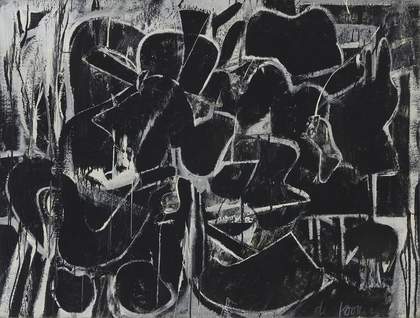
Fig.5
Willem de Kooning
Painting 1948
Enamel and oil on canvas
1083 x 1425 mm
Museum of Modern Art, New York
© Willem de Kooning Revocable Trust/ARS, NY and DACS, London 2017
Notwithstanding these commonalities, it is worth emphasising that much formally differentiated the stylistic breakthroughs of de Kooning and Kline, as a comparison of de Kooning’s Painting of 1948 (fig.5) and Kline’s Nijinsky of 1950 (fig.2) demonstrates. These are perhaps their best-known breakthrough paintings. De Kooning’s Painting features a dynamic jumble of similarly sized and shaped black forms, which are outlined in white, reversing the viewer’s expectation of a black contour line. The dynamism of the composition is twofold. Firstly, the shapes of the forms are such that they seem to push from the edges of the canvas towards its centre and towards each other. In the bottom left corner of the canvas, for instance, there is a backward ‘s’ shape, contorted and on its side, which contradicts and yet reflects a horn- or pipe-shaped ‘u’ that just skirts the bottom of the canvas. The overall impression of tension, increasing towards the centre and relatively shallow in depth, is thus a product of many distinct areas of friction, which are evenly distributed throughout the painting. The second source of dynamism and pictorial unity are the vertical drips and strokes of black and white paint that connect the top of the canvas to the bottom. These are situated seemingly barely before, between and behind the tangled forms. These drips and strokes do seem to be, as the title promises, nothing but painting, and so thematise and picture the medium itself, stripped of any descriptive function, in the same shallow space. Despite the distinction between figure and ground remaining in the composition, one is hard pressed to locate any identifiable or recognisable forms.
Kline’s Nijinsky is comparatively figurative, first of all, in its title. Nijinsky refers to the Russian ballet dancer and tragic public figure of the same name who had suffered from schizophrenia and had only very recently died when Kline made the work.21 The dancer’s death in London was covered in the international press, as was his reburial in Paris.22 Given the painting’s title, the viewer’s expectations and attention are oriented towards a figure, whether human and bodily or otherwise. With its vertical format, Nijinsky is not only titled but also proportioned like a portrait painting. But instead of the mastery, balance and grace that the viewer would anticipate from the name given in the painting’s title, there is an upturned figure, which has been folded and fallen onto itself. Even though the white areas of the painting are articulated with as much rigour and complexity as the black areas, the central figure of Kline’s Nijinsky is heavily outlined in black, as in a conventional contour line. The surrounding areas in white provide an ambiguous but compressed space, as the white is darker on the bottom and the top of the canvas. This combination gives the impression of a black figure on a white background and makes the composition suggestive of not only human but also numerical figures or characters of alphabets both Roman and foreign. As Manny Farber wrote in a review of Kline’s first one-man show in which Nijinksy was exhibited:
This speed fetish, demanding split-second decisions and minimal torment, makes shrewdness the prime weapon of the vanguard artist. Franz Kline (Egan Gallery), housepainting a huge irregular grate or a figure like a sloppy ‘g’ on staring white, achieves a malignant shock that is almost over before it starts.23
Although it is not clear that Nijinsky was Farber’s reference point, the figure in the painting could indeed be read as a detail of a ‘grate’ or, overall, a ‘sloppy “g”’. When Farber wrote that Kline was ‘housepainting’, that was likely an unflattering reference to de Kooning, who had been a housepainter, and thus a critique of Kline, who seemed to be following de Kooning in his use of commercial house paints and broad brushes. Unlike de Kooning’s Painting, however, Kline’s Nijinsky encouraged the viewer to draw figural associations and was thus, by the contemporary standards set by de Kooning and Pollock, less radical in its abstraction.
Reclaiming Kline’s ‘breakthrough’
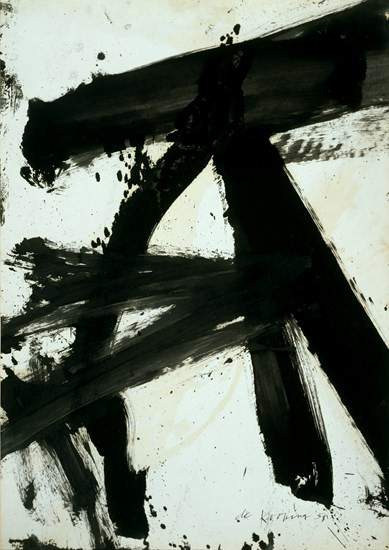
Fig.6
Willem de Kooning
Black and White (Rome) 1959
Museum of Fine Arts, Houston
© Willem de Kooning Revocable Trust/ARS, NY and DACS, London 2017
Before focusing on Kline’s more figurative variety of abstraction, I would like to offer hypothesis: perhaps Kline’s breakthrough, specifically as it relates to de Kooning, became relevant a decade after the fact, because the roles between de Kooning and Kline were temporarily reversed. From September 1959 to January 1960 de Kooning sojourned in Italy, working in Rome, where he produced what are now known as his ‘black and white’ paintings, such as Black and White (Rome) 1959 (fig.6).24 These are highly reminiscent of Kline’s signature style in their combination of bold gestural abstraction, a black and white palette and structured compositions that consist of a series of emphatic strokes that are at odds with each other and positioned at angles that create nearly regular geometric shapes, such as triangles and squares. While these paintings resemble Kline’s works in general, they are unlike any that de Kooning had made before. De Kooning painted these in what appeared to be the original style of Kline after Kline had departed from his black and white palette and started to paint in colour.
This reversal of roles between leader and follower upset the hierarchy that had been established between the artists. Whether a generous gesture towards a fellow artist and friend on the part of de Kooning, an experiment arrived at independently, or simply a teasing or playful act of appropriation or quotation, these paintings could be submitted in favour of Kline’s importance and as evidence that he also influenced de Kooning. Indicatively, whereas in his 1951 book on the abstract expressionists Hess noted, with a diplomatic reluctance, that Kline was ‘[p]ossibly influenced somewhat by de Kooning’, in his 1962 obituary of Kline Hess could write, with a more equitable division of praise for originality, that Kline’s breakthrough was ‘certainly influenced by the examples and personalities of his friends Willem de Kooning and Jackson Pollock, just as surely as his spirit and personality would strongly mark their separate achievements’.25
It would be difficult to prove Kline’s influence upon Pollock, but Kline’s influence upon de Kooning was hard to deny after the latter’s black and white paintings of 1959. There is no evidence that de Kooning and Kline discussed de Kooning’s black and white paintings. But it is likely that Kline was aware of these works, given the two artists’ longstanding friendship; given these works’ proximity in style to Kline’s signature style; given that de Kooning and Kline both found themselves in New York after de Kooning’s return from Italy in January of 1960 and before Kline’s departure for France and Italy in June of 1960; and given that during this period de Kooning and Kline met at least once: at the opening of Kline’s exhibition of new paintings at the Sidney Janis Gallery, which represented de Kooning.26
It is plausible, therefore, that Kline may have returned to his original, breakthrough palette and distinctive variety of bold gestural abstraction in 1960, including in Meryon, in reaction to de Kooning’s black and white works. Perhaps de Kooning reignited Kline’s interest in this style or prompted a desire to defend the forms for which Kline had become known and celebrated, and for which he won an award – the Ministry of Public Instruction Prize – at the Venice Biennale when his work was shown there during the summer and autumn of 1960. Especially as the competition between national schools of abstract painting escalated, breaking out in arguments and even punches in the case of Kline and the French painter Jean Fautrier, it would follow that the internal competition within these national schools also intensified.27 This was certainly true on the French side at the Venice Biennale: in a very unusual move, two artists – Fautrier and Hans Hartung – were awarded Grand Prizes in painting, whereas normally only one was given, because the jury could not decide between the two contenders.28 Within the context of the politics internal to the movement of abstract expressionism, Meryon could thus be seen as a reassertion of Kline’s original, breakthrough style as his own and thus a defence of his personal artistic identity, after Kline himself had turned to colour, around 1955, and left it up for grabs.
Breaking through (to the self and abstraction)
Another way to challenge the theory of Kline’s breakthrough and understand the place of Meryon within Kline’s career is to demonstrate the specific nature of his breakthrough in terms of its personal content and his approach to the figure. Unlike the abstract expressionists, who were immersed in the automatism of European surrealism, the traditional figure was very much Kline’s starting point. Kline studied art at Boston University and the Boston Art Students League during the early 1930s and then continued his artistic education at the Heatherley School of Fine Art in London (1937–8). His training was traditional and conservative by contemporary standards. His discovery of abstraction would thus be born not of an unconscious or involuntary process, but rather of a very deliberate abstraction from the figure that was as psychologically loaded for Kline as it was for the surrealists, albeit more traditionally and less theoretically.
The content of these works was also significant for Kline in a manner that recalls Hess’s description of Kline’s breakthrough in his obituary of the artist: ‘Here railroad engines and cars, city- and landscapes, faces and gestures, are all lost in his shapes; he throws away the tasteful cookery of oil pigment, the direct backing of the Old Masters and all precedence of rules. And his original meaning, his content (raison d’être) are redeemed.’29 Hess characterised ‘content’ for Kline as his ‘original’ meaning; that is, before any break away from naturalistic representation, and as his ‘raison d’être’, the reason for both the painter’s and the painting’s existence. A breakthrough was thus not only technical or professional but also fundamentally personal. The much-heralded breakthroughs of the abstract expressionists can also be seen as emotional and psychological. This is the type of breakthrough of which one speaks in psychotherapy, which, it is important to add, several abstract expressionists underwent, including Pollock. The ultimate quest and reward of this was the discovery of the authentic self. In his landmark essay of 1952 on the artists he referred to as the ‘American action painters’, critic Harold Rosenberg wrote as much:
The American vanguard painter took to the white expanse of the canvas as Melville’s Ishmael took to the sea.
On the one hand, a desperate recognition of moral and intellectual exhaustion; on the other, the exhilaration of an adventure over depths in which he might find reflected the true image of his identity.30
The fact that this search for identity was essentially American is reinforced in Rosenberg’s reference to Herman Melville’s 1851 novel Moby Dick and twice more in the essay’s title and epigraph, which quoted the poet Wallace Stevens: ‘The American will is easily satisfied in its efforts to realize itself in knowing itself.’31 In his attempt to contend with the abstract expressionists as a movement, Rosenberg, like Hess, emphasised the individual and collective existential aspect of what was outwardly an artistic phenomenon. These dual dimensions were detected by painter Robert Motherwell in Kline and his work: ‘Franz projected as a person the sense of a man who was trying to save his own soul through his gift, and that he wanted to share this possible miraculous event with you.’32 Meryon, this essay argues, was in these senses true to contemporary descriptions by Motherwell, Rosenberg and Hess. The painting can be seen as a meditation on personal and national identity, both distinctly and jointly – jointly because the act of striving for personal independence in art during the 1950s was a collective project in the United States.
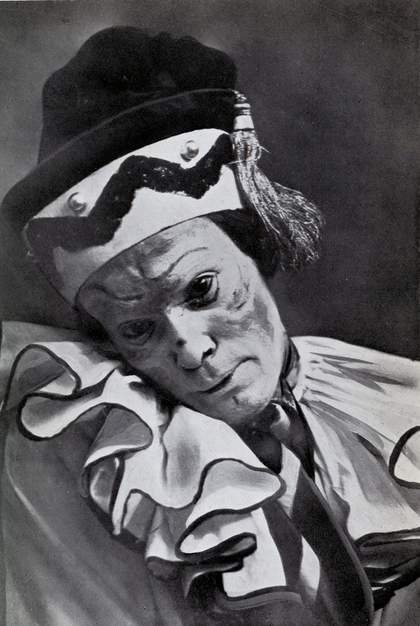
Fig.7
Elliott and Fry
Nijinsky as Petrouchka 1911
Photograph
To reframe all of this according to our initial question: how to explain the enormous stylistic difference between Kline’s paintings of Nijinsky from c.1948 and 1950? It was shortly after moving to London in 1935 that Kline was shown a publicity photograph of Nijinsky as Petrushka, taken by Elliott and Fry at Dover Street Studios in London in 1911 (fig.7), the year that the ballet, composed by Igor Stravinsky and danced by the Ballets Russes, premiered in Paris.33 This photograph served Kline as the inspiration for several drawings and paintings of the ballet dancer throughout the late 1930s and 1940s (such as the paintings Puppet c.1940, Clown c.1941 and Nijinsky 1942, all in private collections), and he returned to it repeatedly, including as part of his breakthrough to abstraction.
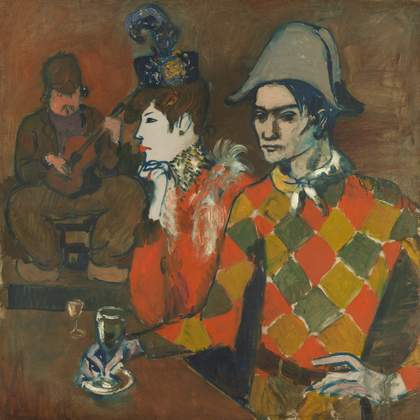
Fig.8
Pablo Picasso
At the Lapin Agile 1905
Metropolitan Museum of Art, New York
In 1937 Kline met Elizabeth Parsons, a ballerina and his future wife, who shared Kline’s admiration for Nijinsky.34 After Kline’s death, Elizabeth recalled in an interview: ‘He was overcome by the photo of Nijinsky as Petrouchka. It was apropos of this that he went on about [actor and clown] Lon Chaney. He said he knew what Petrouchka felt and Lon Chaney in his circus clown tragedy.’35 Kline had told Elizabeth in London: ‘I have always felt that I’m like a clown and that my life might work out like a tragedy, a clown’s tragedy.’36 Kline’s emotional investment in the figure of the clown was private and mediated by the figure of Nijinsky, but the selection of this subject matter and its repetition publicly inscribed Kline within an esteemed tradition of fine art: namely the depiction of the commedia dell’arte in modern art as a form of surrogate self-portraiture, as seen, for instance, in Pablo Picasso’s At the Lapin Agile of 1905 (fig.8). Kline’s identification with Nijinsky, the virtuoso ballet dancer whose life, like his role as the clown-puppet in the ballet Petrushka, proved tragic, demonstrates Kline’s belief in the nineteenth-century romantic metaphor of the artist as clown, who is cruelly condemned, despite his talents, to loneliness, neglect, alienation and oblivion.37
In his many portraits of Nijinsky created throughout the 1930s and 1940s, Kline was relying upon the viewer’s cultural knowledge of Nijinsky’s life and the ballet Petrushka in order to heighten the emotive power of these paintings, just as he did in the abstract version of 1950. Although we have seen earlier in this essay how the latter painting can be described in terms of its abstraction, there is also a way of reading it according to its dramatic and emotional content. Nijinsky seems to depict a figure turned upside down (which may explain why the curator accidentally reversed it in the 1960 Venice Biennale display). The clown-puppet’s dark, conical cap is in the bottom left corner of the painting and there is the suggestion of a head squeezed on the floor and a neck twisting away from the round torso, on which the ruffles of the clown’s costume are still discernible. The clown’s legs flail in the air, under a structure, perhaps the chair or table onto which the puppet had been propped. The hierarchy of the composition, from the furniture-like structure on top, is doubly upsetting, the emotions following what appears to have been a fall, or a violent push or assault, as by the Moor in the ballet. This upper structure, seemingly hanging in thin air, could also double as a sword or a weapon, threatening to collapse onto the already crushed puppet and kept aloft only by its continuation out of the canvas on the right hand side.
Not only is there dramatic and expressive content in Kline’s ostensibly purely abstract Nijinsky of 1950, but Kline’s figurative Large Clown (Nijinsky as Petrouchka) of c.1948 (fig.1) is arguably closer to Kline’s mature, abstract style than one would believe at first glance. Kline’s fixation with the Elliott and Fry photograph of Nijinsky since the mid-1930s arguably helps to explain his breakthrough to abstraction more than a decade later in a different way. A photograph is already inherently abstract, in that it reduces three dimensions to two dimensions. That Kline repeatedly chose to work from the photographic image indicates that despite his academic training, which included drawing from a live model, he preferred to work from a medium that artificially, or a priori, flattened and circumscribed reality within a frame and drained it of colour. It also indicates Kline’s interests in tonal range, even where that range is superimposed, as on Nijinsky’s made-up face, which is painted in white in Large Clown, with some wrinkles of worry and cheekbones of hunger in black. Furthermore, Kline owned a reproduction of the Elliott and Fry photograph that was particularly painterly. This was the version, seen in fig.7, which was included in the biography of Nijinsky published by his wife Romola de Pulszky. The photograph has been retouched with paint on its surface – the ruffles on the left shoulder, for instance, have been enhanced by painterly strokes.38 The face paint on Nijinsky as well as the paint on the photograph must have served as encouragement for Kline. Although not black and white, even Kline’s figurative Large Clown of 1948 is very nearly in grisaille, with only some isolated hints of blood red in the eyes and a softer red around the neck to foreshadow Petrushka’s impending death.
Because Kline sketched and painted this photograph so many times, he acquired such a familiarity with it that he could apparently sketch it blindfolded in less than thirty seconds.39 This skill necessarily involved what Kline had described in 1956 as the process that had led to his breakthrough to abstraction: ‘breaking down the structure into essential elements’.40 In the photograph, the posture of Nijinsky in absolute terms and relative to the frame has a striking structure of a kind that persists in Kline’s abstract work, in which there is a tension between the composition internal to the painting and the limits of the canvas.
Nijinsky, who plays a puppet, cocks his head to the side in a self-deprecating gesture that emphasises his lack of agency. His raised right shoulder, head and gaze press upon the left edge of the photograph and out towards the viewer. Nijinsky’s performance of a puppet poses the question: what if an animate object lacks agency? This is a question with implications for figuration in art as well as for the self, struggling in the world to exert control over motions, emotions and fate, as the abstract expressionists were during the early post-war period. If, as Harry Gaugh first demonstrated, Nijinsky could reliably serve Kline as a surrogate in self-portraiture during the 1930s and 1940s, including in his breakthrough to abstraction, the historical and artistic figure of Charles Meryon could arguably fulfil a similar function in Meryon in 1960, albeit under different circumstances.41 Meryon was, like Nijinsky, celebrated as a virtuoso by his contemporaries and famously plagued by mental illness, dying in an asylum at Charenton in 1868 at only forty-seven years of age. As is explored more fully elsewhere in this In Focus, Kline associated himself near the end of his life, as early in his career, with a doomed, tragic figure in Meryon – except not a puppet or a dancer playing a puppet but rather a master of etching.42 In Meryon Kline identifies the figure of Meryon with his own style of painting.
This metaphor of the artist as tragic figure had credibility, including in the early days of abstract expressionism, when American society did not hold modern art or artists in high regard. But as the general outlook as well as the market for contemporary American art improved during the late 1950s, the metaphor no longer had traction. For instance, the spotlight that Life magazine shone in its feature on four abstract expressionist artists in 1959 – Kline, de Kooning, Rothko and Clyfford Still – was flattering, aggrandising and even glamorous.43 Kline also saw his own fortunes change towards the end of his life: not only were there no more evictions from freezing cold flats, but during the late 1950s and early 1960s Kline purchased a townhouse in New York, a summer home in Provincetown, a Ferrari and a Thunderbird, and even received an invitation to a White House dinner in 1962.44 Kline the bohemian had become comfortably bourgeois.
Breaking into (abstract expressionism)
Perhaps the most logical way to challenge what Ashton called the ‘Saul-into-Paul conversion theory’ of Kline’s breakthrough, which was invented by Elaine de Kooning, is to ask why it was so important and necessary at the time of his death, what purpose the story served at that time, and why it has endured. Unlike the prototypical abstract expressionist immortalised in Rosenberg’s article ‘The American Action Painters’, Kline relied heavily upon sketches in order to methodically execute his paintings.45 He did not spontaneously improvise directly on the canvas in a variation on automatism that had been adopted from the surrealists. This distinction in working method was crucial because abstract expressionist artists during the early 1950s were supposedly identifiable precisely through their rejection of the preparatory sketch. In his essay of 1952, Rosenberg quoted an artist, left anonymous, speaking about another artist, also left anonymous: ‘“B. is not modern,” one of the leaders of this mode said to me the other day. “He works from sketches. That makes him Renaissance.”’46
A reader of the December 1952 issue of Art News in which Rosenberg’s essay was published could not have failed to be struck by the dissonance between Rosenberg’s definition of the abstract expressionist mode and Kline’s working process, as recounted by Goodnough in ‘Kline Paints a Picture’, which was published in the same issue. Goodnough carefully negotiated this difference by arguing at once for the diversity of Kline’s process and the importance of the sketches used only in retrospect:
That Kline’s paintings do not result from any preconceived formula is evident from the fact that, as he points out, each one has a different way of being realized – some come quickly, others go through numerous changes (white over black, black over white, repeatedly) before he considers them finished … To say he prepared for the painting is somewhat incorrect, for while many sketches and drawings were done before it was started, it was as a result of looking backward that the painting was conceived.47
Such circumlocution seemed necessary, at least early on, in defence of Kline’s work. It worked, or perhaps the definition of the abstract expressionist was relaxed or Kline’s use of sketches was forgotten, such that the art critic and poet Frank O’Hara could later write: ‘[Kline] is the Action Painter par excellence’.48 Emphasising the moment of breakthrough served to give an impression of compressed time, so that this unique episode could stand in for all of the works, which Kline had painted much more slowly and with sketches.
The agenda of Kline’s advocates was clear: to ensure the inclusion of Kline within the abstract expressionist canon, even though there were essential differences between the abstract expressionist norm and Kline’s academic artistic background, passage to abstraction and deliberate working method. Nevertheless, Kline adhered to the tropes of abstract expressionism in many respects, including in his conception of artistic subjectivity, his belief in emotional expression and his uses of the large-format canvas, reduced palette and inexpensive, industrial paints. He was, moreover, a member and leader of this group by virtue of his organisation of many of the gatherings and exhibitions associated with it.
We can therefore conclude by observing that Kline’s breakthrough – if there was a singular, unique breakthrough – became particularly significant towards the end of his life and after his death for multiple reasons. It was dramatised and amplified in an effort to assimilate Kline more thoroughly into the abstract expressionist pantheon. As Hess wrote in his mythologising obituary for Kline, ‘Starting with motifs from swift brush drawings, wrenched out of scale by enlargement, he forged a style and an image out of the broken past with the verve and speed that Siegfried forged his sword.’49 Even if Kline had not produced his paintings with the speed commonly associated with abstract expressionism, his breakthrough to abstraction was understood in metaphorical terms as a coming-of-age event out of Wagnerian opera – and not only because Kline sometimes listened to Wagner while he worked. It was presented as an operatic testament to his artistic maturity and masculinity.
During the late 1950s and early 1960s, the stakes of Kline’s breakthrough increased at the same time that abstract expressionism acquired its standing as the first original American avant-garde movement. The notion of the breakthrough became pervasive, not only in the accounts of individual artists, but also, increasingly, in collective accounts of the movement. The Americans had broken away from the European and especially French tradition of modern painting, or, in the period language, ‘the tasteful cookery of oil pigment, the direct backing of the Old Masters and all precedence of rules’, as Hess wrote in his obituary of Kline.50 As is recorded in one of the news reports of the acrimonious exchange between Fautrier and Kline at the Venice Biennale of 1960, when Fautrier pronounced an insult to the effect of ‘U.S. Go Home!’, Kline is said to have responded, ‘French cook!’.51 The rhetoric of praise in abstract expressionism, like that of insult, was gendered and nationalistic. While French artists like Fautrier were baking pastries in tawdry pastels with ornamental layers of impasto, American artists, like Kline, were forging swords out of commercial, industrial paints. Kline may have been reflecting on this period rhetoric when he decided, shortly after the tabloid-worthy tussle with Fautrier at the Venice Biennale, to turn to the celebrated French printmaker of the nineteenth century in Meryon.
